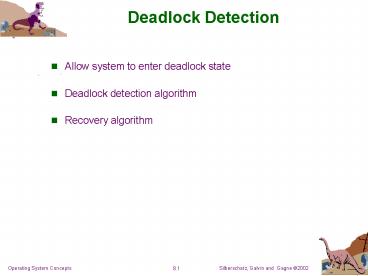Deadlock Detection - PowerPoint PPT Presentation
1 / 10
Title:
Deadlock Detection
Description:
Abort one process at a time until deadlock cycle is eliminated ... How to select the processes to abort? Aborting a process may leave files/devices/semaphores ... – PowerPoint PPT presentation
Number of Views:93
Avg rating:3.0/5.0
Title: Deadlock Detection
1
Deadlock Detection
- Allow system to enter deadlock state
- Deadlock detection algorithm
- Recovery algorithm
2
Single Instance of Each Resource Type
- Maintain wait-for graph
- Nodes are processes.
- Pi ? Pj if Pi is waiting for Pj.
- A deadlock exists if and only if the wait-for
graph contains a cycle - To detect deadlocks, periodically invoke an
algorithm that searches for a cycle in the graph.
3
Resource-Allocation Graph and Wait-for Graph
Resource-Allocation Graph
Corresponding wait-for graph
4
Several Instances of a Resource Type
- Algorithm inputs
- Available A vector of length m indicates the
number of available resources of each type. - Allocation An n x m matrix defines the number
of resources of each type currently allocated to
each process. - Request An n x m matrix indicates the current
request of each process. If Request i,j k,
then process Pi is requesting k more instances of
resource type Rj.
5
Deadlock Detection Algorithm
- 1. Let Work and Finish be vectors of length m and
n, respectively Initialize - (a) Work Available
- (b) For i 1,2, , n, if Allocationi ? 0, then
Finishi falseotherwise, Finishi true. - 2. Find an index i such that both
- Finishi false
- Requesti ? Work
- If no such i exists, go to step 4.
- 3. Work Work AllocationiFinishi truego
to step 2. - 4. If Finishi false, for some i, 1 ? i ? n,
then the system is in deadlock state. Moreover,
if Finishi false, then Pi is deadlocked.
6
Example of Detection Algorithm
- 5 processes P0 through P4 3 resource types A (7
instances), B (2 instances), and C (6 instances). - Snapshot at time T0
- Allocation Request Available
- A B C A B C A B C
- P0 0 1 0 0 0 0 0 0 0
- P1 2 0 0 2 0 2
- P2 3 0 3 0 0 0
- P3 2 1 1 1 0 0
- P4 0 0 2 0 0 2
- No deadlock sequence ltP0, P2, P3, P1, P4gt will
result in Finishi true for all i.
7
Example (Cont.)
- P2 requests an additional instance of type C.
- Allocation Request Available
- A B C A B C A B C
- P0 0 1 0 0 0 0 0 0 0
- P1 2 0 0 2 0 2
- P2 3 0 3 0 0 1
- P3 2 1 1 1 0 0
- P4 0 0 2 0 0 2
- Deadlock exists, consisting of processes P1, P2,
P3, and P4.
8
Detection Algorithm Usage
- When to invoke deadlock detection algorithm?
- Every time a request cant be granted
- Considerable overhead
- At less frequent intervals, e.g., once per hour,
or whenever CPU utilization drops below 40 - More processes are deadlocked
9
Recovery from Deadlock Process Abortion
- Abort one or more processes to break the circular
wait - Abort all deadlocked processes.
- Large waste of CPU time
- Abort one process at a time until deadlock cycle
is eliminated - Large overhead must invoke detection algorithm
after a process is aborted - How to select the processes to abort?
- Aborting a process may leave files/devices/semapho
res in improper states
10
Recovery from Deadlock Resource Preemption
- Preempt some resources from one or more of the
- deadlocked processes
- Selecting a victim minimize cost.
- Rollback return to some safe state, restart
process from that state. - Starvation same process may always be picked as
victim - Remedy include number of rollbacks in cost
factor.































